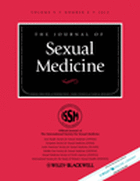
Compared with uncircumcised men, circumcised men have accumulated larger numbers of STI in their lifetime, have higher rates of previous diagnosis of warts, and were more likely to have HIV infection. Results indicate that being circumcised predicted the likelihood of HIV infection."
ABSTRACT
Introduction. Circumcision among adult men has been widely promoted as a strategy to reduce human immunodeficiency virus (HIV) transmission risk. However, much of the available data derive from studies conducted in Africa, and there is as yet little research in the Caribbean region where sexual transmission is also a primary contributor to rapidly escalating HIV incidence.
Aim. In an effort to fill the void of data from the Caribbean, the objective of this article is to compare history of sexually transmitted infections (STI) and HIV diagnosis in relation to circumcision status in a clinic-based sample of men in Puerto Rico.
Methods. Data derive from an ongoing epidemiological study being conducted in a large STI/HIV prevention and treatment center in San Juan in which 660 men were randomly selected from the clinic's waiting room.
Main Outcome Measures. We assessed the association between circumcision status and self-reported history of STI/HIV infection using logistic regressions to explore whether circumcision conferred protective benefit.
Results. Almost a third (32.4%) of the men were circumcised (CM). Compared with uncircumcised (UC) men, CM have accumulated larger numbers of STI in their lifetime (CM = 73.4% vs. UC = 65.7%; P = 0.048), have higher rates of previous diagnosis of warts (CM = 18.8% vs. UC = 12.2%; P = 0.024), and were more likely to have HIV infection (CM = 43.0% vs. UC = 33.9%; P = 0.023). Results indicate that being CM predicted the likelihood of HIV infection (P value = 0.027).
Conclusions. These analyses represent the first assessment of the association between circumcision and STI/HIV among men in the Caribbean. While preliminary, the data indicate that in and of itself, circumcision did not confer significant protective benefit against STI/HIV infection. Findings suggest the need to apply caution in the use of circumcision as an HIV prevention strategy, particularly in settings where more effective combinations of interventions have yet to be fully implemented.
Rodriguez-Diaz CE, Clatts MC, Jovet-Toledo GG, Vargas-Molina RL, Goldsamt LA, and García H. More than foreskin: Circumcision status, history of HIV/STI, and sexual risk in a clinic-based sample of men in Puerto Rico. J Sex Med

 RSS Feed
RSS Feed

